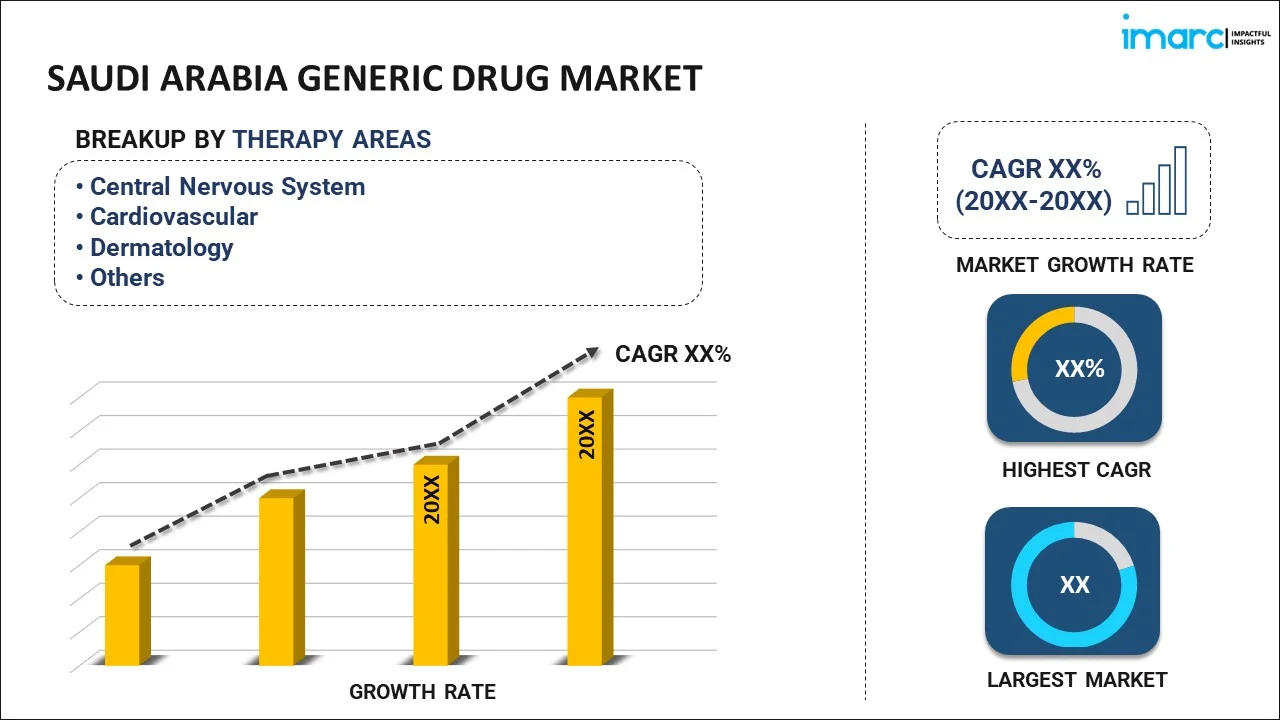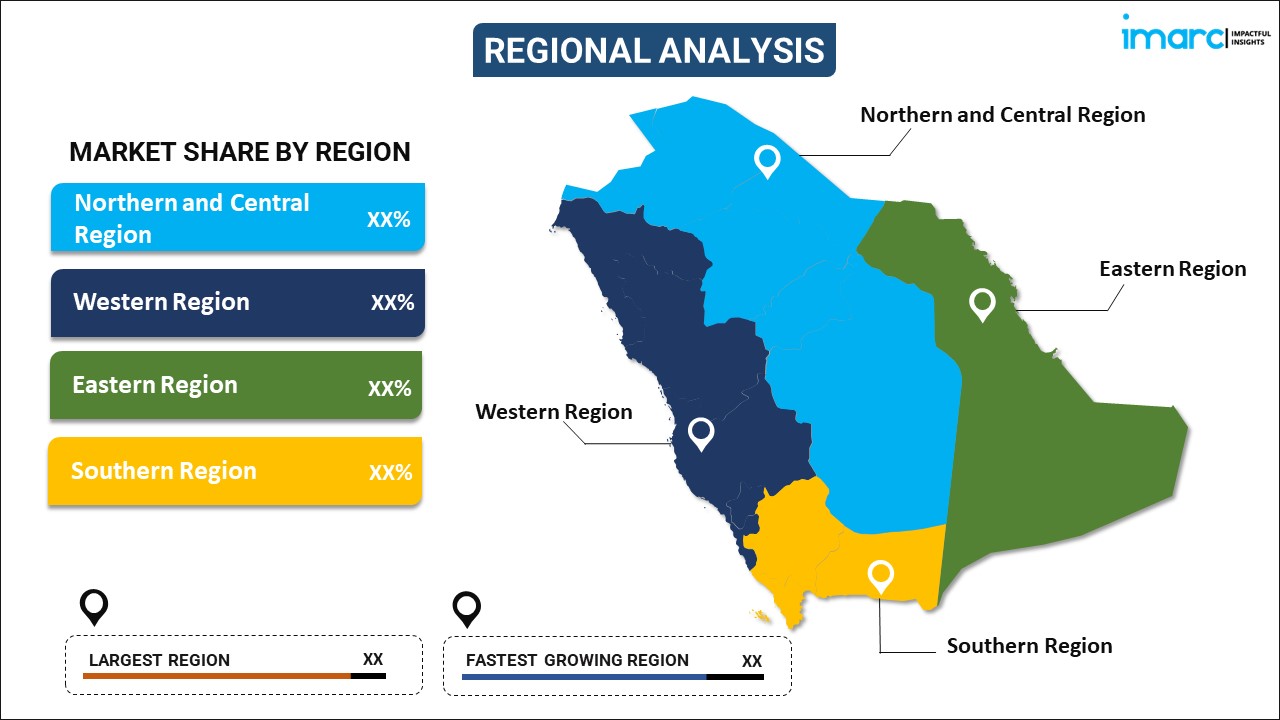
Saudi Arabia Generic Drug Market Report by Therapy Area (Central Nervous System, Cardiovascular, Dermatology, Genitourinary/Hormonal, Respiratory, Rheumatology, Diabetes, Oncology, and Others), Drug Delivery (Oral, Injectables, Dermal/Topical, Inhalers), Distribution Channel (Retail Pharmacies, Hospital Pharmacies), and Region 2025-2033
Market Overview:
Saudi Arabia generic drug market size reached USD 3.8 Billion in 2024. Looking forward, IMARC Group expects the market to reach USD 8.0 Billion by 2033, exhibiting a growth rate (CAGR) of 7.9% during 2025-2033. The favorable government initiatives, rising healthcare costs, patent expirations, increasing prevalence of chronic diseases, growth of the pharmaceutical industry, rapid healthcare infrastructure development, and regulatory framework of SFDA in ensuring the safety, quality and efficacy of generic drugs represent some of the key factors driving the market.
|
Report Attribute
|
Key Statistics
|
|---|---|
|
Base Year
|
2024 |
|
Forecast Years
|
2025-2033
|
|
Historical Years
|
2019-2024
|
| Market Size in 2024 | USD 3.8 Billion |
| Market Forecast in 2033 | USD 8.0 Billion |
| Market Growth Rate (2025-2033) | 7.9% |
Generic drugs are pharmaceutical products that are essentially identical to their brand-name counterparts in terms of active ingredients, dosage, strength, and intended use. These medications are typically developed after the patent protection of the original brand-name drug expires. One key distinction between generic and brand-name drugs is the cost. Generic drugs are often more affordable, making them an attractive option for patients and healthcare systems looking to reduce healthcare expenditures.
Saudi Arabia Generic Drug Market Trends:
Generic drugs are often more affordable than their brand-name counterparts, making them an attractive option for both patients and healthcare providers. This cost-effectiveness drives the demand for generic medications in Saudi Arabia. Additionally, as patents for several brand-name drugs have expired or are approaching expiration in Saudi Arabia, it has opened up opportunities for generic drug manufacturers to enter the market. This leads to increased competition, which can further drive down drug prices. Other than this, the prevalence of chronic diseases, such as diabetes, cardiovascular diseases, and hypertension, is on the rise in Saudi Arabia. Generic drugs offer a cost-effective solution for managing these conditions, contributing to their market growth. Besides this, the Saudi pharmaceutical industry has been expanding, with investments in research and manufacturing capabilities. This growth includes the production of generic drugs, meeting domestic demand, and potentially exporting to other markets in the region. In line with this, the expanding health insurance coverage in Saudi Arabia has made it easier for patients to afford medications, including generic drugs. This has boosted the demand for cost-effective treatment options. Furthermore, investments in healthcare infrastructure and the expansion of healthcare facilities in Saudi Arabia have increased access to healthcare services. This has led to a higher demand for medications, including generic drugs, to meet the needs of a growing population. Moreover, the Saudi Food and Drug Authority (SFDA) plays a crucial role in regulating the pharmaceutical industry. The commitment of the SFDA to ensuring the safety, quality, and efficacy of generic drugs instills confidence in both healthcare providers and patients. The adoption of digital health technologies and electronic medical records has facilitated better prescription management and monitoring of medication adherence. This has increased the demand for generic drugs, which are readily available and easily prescribed through digital systems. Apart from this, pharmaceutical companies in Saudi Arabia are forming strategic alliances and partnerships with international generic drug manufacturers. This collaboration enhances the availability of a wider range of generic medications in the market.
Saudi Arabia Generic Drug Market Segmentation:
IMARC Group provides an analysis of the key trends in each segment of the market, along with forecasts at the country level for 2025-2033. Our report has categorized the market based on therapy area, drug delivery, and distribution channel.
Therapy Area Insights:

- Central Nervous System
- Cardiovascular
- Dermatology
- Genitourinary/Hormonal
- Respiratory
- Rheumatology
- Diabetes
- Oncology
- Others
The report has provided a detailed breakup and analysis of the market based on the therapy area. This includes central nervous system, cardiovascular, dermatology, genitourinary/hormonal, respiratory, rheumatology, diabetes, oncology, and others.
Drug Delivery Insights:
- Oral
- Injectables
- Dermal/Topical
- Inhalers
A detailed breakup and analysis of the market based on the drug delivery have also been provided in the report. This includes oral, injectables, dermal/topical, and inhalers.
Distribution Channel Insights:
- Retail Pharmacies
- Hospital Pharmacies
The report has provided a detailed breakup and analysis of the market based on the distribution channel. This includes retail pharmacies and hospital pharmacies.
Regional Insights:

- Northern and Central Region
- Western Region
- Eastern Region
- Southern Region
The report has also provided a comprehensive analysis of all the major regional markets, which include Northern and Central Region, Western Region, Eastern Region, and Southern Region.
Competitive Landscape:
The market research report has also provided a comprehensive analysis of the competitive landscape in the market. Competitive analysis such as market structure, key player positioning, top winning strategies, competitive dashboard, and company evaluation quadrant has been covered in the report. Also, detailed profiles of all major companies have been provided.
Saudi Arabia Generic Drug Market Report Coverage:
| Report Features | Details |
|---|---|
| Base Year of the Analysis | 2024 |
| Historical Period | 2019-2024 |
| Forecast Period | 2025-2033 |
| Units | Billion USD |
| Scope of the Report | Exploration of Historical and Forecast Trends, Industry Catalysts and Challenges, Segment-Wise Historical and Predictive Market Assessment:
|
| Therapy Areas Covered | Central Nervous System, Cardiovascular, Dermatology, Genitourinary/Hormonal, Respiratory, Rheumatology, Diabetes, Oncology, Others |
| Drug Deliveries Covered | Oral, Injectables, Dermal/Topical, Inhalers |
| Distribution Channels Covered | Retail Pharmacies, Hospital Pharmacies |
| Regions Covered | Northern and Central Region, Western Region, Eastern Region, Southern Region |
| Customization Scope | 10% Free Customization |
| Post-Sale Analyst Support | 10-12 Weeks |
| Delivery Format | PDF and Excel through Email (We can also provide the editable version of the report in PPT/Word format on special request) |
Key Questions Answered in This Report:
- How has the Saudi Arabia generic drug market performed so far and how will it perform in the coming years?
- What has been the impact of COVID-19 on the Saudi Arabia generic drug market?
- What is the breakup of the Saudi Arabia generic drug market on the basis of therapy area?
- What is the breakup of the Saudi Arabia generic drug market on the basis of drug delivery?
- What is the breakup of the Saudi Arabia generic drug market on the basis of distribution channel?
- What are the various stages in the value chain of the Saudi Arabia generic drug market?
- What are the key driving factors and challenges in the Saudi Arabia generic drug?
- What is the structure of the Saudi Arabia generic drug market and who are the key players?
- What is the degree of competition in the Saudi Arabia generic drug market?
Key Benefits for Stakeholders:
- IMARC’s industry report offers a comprehensive quantitative analysis of various market segments, historical and current market trends, market forecasts, and dynamics of the Saudi Arabia generic drug market from 2019-2033.
- The research report provides the latest information on the market drivers, challenges, and opportunities in the Saudi Arabia generic drug market.
- Porter's five forces analysis assist stakeholders in assessing the impact of new entrants, competitive rivalry, supplier power, buyer power, and the threat of substitution. It helps stakeholders to analyze the level of competition within the Saudi Arabia generic drug industry and its attractiveness.
- Competitive landscape allows stakeholders to understand their competitive environment and provides an insight into the current positions of key players in the market.
Need more help?
- Speak to our experienced analysts for insights on the current market scenarios.
- Include additional segments and countries to customize the report as per your requirement.
- Gain an unparalleled competitive advantage in your domain by understanding how to utilize the report and positively impacting your operations and revenue.
- For further assistance, please connect with our analysts.
 Inquire Before Buying
Inquire Before Buying
 Speak to an Analyst
Speak to an Analyst
 Request Brochure
Request Brochure
 Request Customization
Request Customization




.webp)




.webp)












